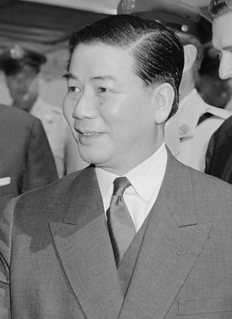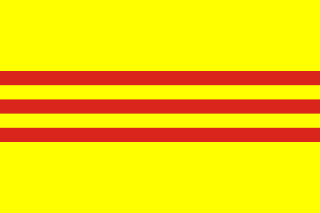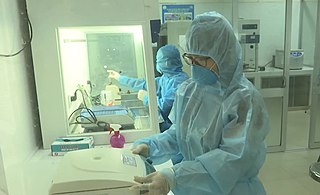
Agent Orange is a herbicide and defoliant chemical, one of the "tactical use" Rainbow Herbicides. It is widely known for its use by the U.S. military as part of its herbicidal warfare program, Operation Ranch Hand, during the Vietnam War from 1961 to 1971. It is a mixture of equal parts of two herbicides, 2,4,5-T and 2,4-D. In addition to its damaging environmental effects, traces of dioxin found in the mixture have caused major health problems for many individuals who were exposed, and their offspring.

Southeast Asia, also spelled South East Asia and South-East Asia, and also known as Southeastern Asia or SEA, is the geographical southeastern subregion of Asia, consisting of the regions that are south of China, south-east of the Indian subcontinent and north-west of Australia. Southeast Asia is bordered to the north by East Asia, to the west by South Asia and the Bay of Bengal, to the east by Oceania and the Pacific Ocean, and to the south by Australia and the Indian Ocean. Apart from the British Indian Ocean Territory and two out of 26 atolls of Maldives in South Asia, Southeast Asia is the only other subregion of Asia that lies partly within the Southern Hemisphere. The majority of the subregion is still in the Northern Hemisphere. East Timor and the southern portion of Indonesia are the only parts that are south of the Equator.

The People's Army of Vietnam, also known as the Vietnamese People's Army (VPA), is the military force of the Socialist Republic of Vietnam. The PAVN is a part of the Vietnam People's Armed Forces and includes: Ground Force, Navy, Air Force, Border Guard & Coast Guard. However, Vietnam does not have a separate Ground Force or Army branch. All ground troops, army corps, military districts and specialised arms belong to the Ministry of Defence, directly under the command of the Central Military Commission, the Minister of Defence, and the General Staff of the Vietnam People's Army. The military flag of the PAVN is the flag of the Socialist Republic of Vietnam, with the words Quyết thắng added in yellow at the top left.

The Vietnam War, also known as the Second Indochina War, was a conflict in Vietnam, Laos, and Cambodia from 1 November 1955 to the fall of Saigon on 30 April 1975. It was the second of the Indochina Wars and was officially fought between North Vietnam and South Vietnam. North Vietnam was supported by the Soviet Union, China, and other communist allies; South Vietnam was supported by the United States, South Korea, the Philippines, Australia, Thailand, and other anti-communist allies. The war, considered a Cold War-era proxy war by some, lasted almost 20 years, with direct U.S. involvement ending in 1973, and included the Laotian Civil War and the Cambodian Civil War, which ended with all three countries becoming communist states in 1975.

French Indochina, officially known as the Indochinese Union and after 1947 as the Indochinese Federation, was a grouping of French colonial territories in Southeast Asia until its demise in 1954. It comprised Cambodia, Laos, the Chinese territory of Guangzhouwan, and the Vietnamese regions of Tonkin in the north, Annam in the centre, and Cochinchina in the south. The capital for most of its history (1902–45) was Hanoi; Saigon was the capital from 1887 to 1902 and again from 1945 to 1954.

Ngô Đình Diệm was a Vietnamese politician. He was the final prime minister of the State of Vietnam (1954–55), and then served as President of South Vietnam from 1955 until he was captured and assassinated during the 1963 military coup.

Hanoi is the capital city of Vietnam. It covers an area of 3,358.6 km2 (1,296.8 sq mi). The second largest city in Vietnam, it consists of 12 urban districts, 1 district-leveled town and 17 rural districts. Located within the Red River Delta, Hanoi is the cultural and political centre of Vietnam.

South Vietnam, officially the Republic of Vietnam, was a country that existed from 1955 to 1975, the period when the southern portion of Vietnam was a member of the Western Bloc during part of the Cold War. It first received international recognition in 1949 as the State of Vietnam within the French Union, with its capital at Saigon, before becoming a republic in 1955. South Vietnam was bordered by North Vietnam to the north, Laos to the northwest, Cambodia to the southwest, and Thailand across the Gulf of Thailand to the southwest. Its sovereignty was recognized by the United States and 87 other nations, though it failed to gain admission into the United Nations as a result of a Soviet veto in 1957.

Ho Chi Minh City, commonly and formerly officially known as Saigon, is the largest city in Vietnam, situated in the south. In the southeastern region, the city surrounds the Saigon River and covers about 2,061 square kilometres.

Hồ Chí Minh, born Nguyễn Sinh Cung, also known as Nguyễn Tất Thành, Nguyễn Ái Quốc, Bác Hồ, Người cha dân tộc or simply Bác, was a Vietnamese revolutionary and politician. He served as Prime Minister of Democratic Republic of Vietnam from 1945 to 1955 and President from 1945 until his death in 1969. Ideologically a Marxist–Leninist, he served as Chairman and First Secretary of the Workers' Party of Vietnam. He was born in Nghệ An province, in Central Vietnam.

The Việt Minh was a national independence coalition formed at Pác Bó by Hồ Chí Minh on May 19, 1941. Also known as the Việt Minh Front, it was created by the Indochinese Communist Party as a form of united national front in Vietnam.

The Viet Cong, officially known as the National Liberation Front of South Vietnam, was an armed communist political revolutionary organization in South Vietnam and Cambodia. Its military force, the Liberation Army of South Vietnam (LASV), fought under the direction of North Vietnam, against the South Vietnamese and United States governments during the Vietnam War, eventually emerging on the winning side. The LASV had both guerrilla and regular army units, as well as a network of cadres who organized peasants in the territory the Viet Cong controlled. During the war, communist fighters and anti-war activists claimed that the Viet Cong was an insurgency indigenous to the South, while the U.S. and South Vietnamese governments portrayed the group as a tool of North Vietnam.

Vietnam, officially the Socialist Republic of Vietnam, is a country in Southeast Asia. Located at the eastern edge of mainland Southeast Asia, it covers 311,699 square kilometres. With a population of over 96 million, it is the world's fifteenth-most populous country. Vietnam borders China to the north, Laos and Cambodia to the west, and shares maritime borders with Thailand through the Gulf of Thailand, and the Philippines, Indonesia, and Malaysia through the South China Sea. Its capital is Hanoi and its largest city is Ho Chi Minh City.

The Sino-Vietnamese War was a border war fought between China and Vietnam in early 1979. China launched an offensive in response to Vietnam's actions against the Khmer Rouge in 1978, which ended the rule of the Chinese-backed Khmer Rouge. Both China and Vietnam claimed victory in the last of the Indochina Wars.

The Vietnamese people or Kinh people are a Southeast Asian ethnic group originally native to modern-day Northern Vietnam and Southern China. The native language is Vietnamese, the most widely spoken Austroasiatic language. Its vocabulary was influenced by Chinese early on. During the French colonial era, French was an official language in Vietnam. Afterwards, the Vietnamese language codified in the Latin alphabet emerged.

The Vietnam national football team represents Vietnam in international football and is controlled by the Vietnam Football Federation, the governing body of football in Vietnam.

The Cambodian–Vietnamese War, known in Vietnam as the Counter-offensive on the Southwestern border, and by Cambodian nationalists as the Vietnamese invasion of Cambodia, was an armed conflict between Democratic Kampuchea, controlled by the Khmer Rouge, and the Socialist Republic of Vietnam. The war began with repeated attacks by the Kampuchean Revolutionary Army on the southwestern border of Vietnam, particularly the Ba Chuc massacre which resulted in the deaths of over 3,000 Vietnamese civilians. On 25 December 1978, Vietnam launched a full-scale invasion of Kampuchea, and subsequently occupied the country and removed the government of the Communist Party of Kampuchea from power.

The Voice of Vietnam is the Vietnamese national radio broadcaster. Directly controlled by the government of Vietnam, it is tasked with propagating the policies of the Party and the laws of the state.

North Vietnam, officially the Democratic Republic of Vietnam, was a state in Southeast Asia from 1945 to 1954, and a country from 1954 to 1976.

The COVID-19 pandemic in Vietnam is part of the ongoing global pandemic of coronavirus disease 2019 caused by severe acute respiratory syndrome coronavirus 2. As of 31 December 2021, Vietnam has officially reported 1,731,257 laboratory confirmed cases, 1,355,286 recoveries, and 32,394 deaths, the 3rd highest in Southeast Asia after Indonesia, the Philippines; and the 31st highest in the world. Hồ Chí Minh City is the most-affected locale with 504,583 confirmed cases and 19,152 deaths, but the Vietnam Ministry of Health estimated that the real number of cases may be four to five times higher.





















